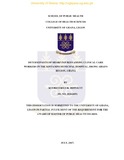UGSpace Repository
Determinants of Sharp Injuries among Clinical Care Workers in the Kintampo Municipal Hospital, Brong Ahafo Region, Ghana
- UGSpace Home
- →
- Theses
- →
- Masters
- →
- College of Health Sciences
- →
- School of Public Health
- →
- View Item
JavaScript is disabled for your browser. Some features of this site may not work without it.
| dc.contributor.author | Hippolyt, K. | |
| dc.date.accessioned | 2018-08-06T11:58:06Z | |
| dc.date.available | 2018-08-06T11:58:06Z | |
| dc.date.issued | 2017-07 | |
| dc.identifier.uri | http://ugspace.ug.edu.gh/handle/123456789/23755 | |
| dc.description.abstract | Background: Occupational injury is a global public health problem in terms of disability adjusted life years which contributed to 1.5% of all cases with estimated economic loss of 5% - 10% gross national domestic productivity. The International Labour Organization (ILO) estimated that about 2.3 million workers die each year from unintentional work-related accidents and diseases. Healthcare workers are more likely to experience work-related injuries than are workers in most other occupations. Sharp injury (SIs) occurs when sharp instruments such as needle penetrates the skin. If the sharp instrument is contaminated with infectious blood and body fluids, there is the potential for transmission of infections. Globally, more than 35 million healthcare workers (HCWs) suffer from occupational injuries due to sharp objects such as needle sticks every year. Even though efforts have been made to reduce the incidence of sharp injuries, the problem still persist. This study therefore aimed to find out determinants of sharp injuries among clinical care workers at the Kintampo Municipal Hospital in the Brong Ahafo Region of Ghana. Methods: A cross-sectional study was conducted among clinical care workers between May and June 2017. The study population was divided into seven strata (i.e. seven units) proportionately. Simple random sampling method was used to select respondents from the various units. The units were serially numbered where the first unit was numbered U/001, the second unit numbered U/002 until the sample size for the cluster was exhausted. A total sample size of 152 healthcare workers was studied. Structured questionnaires were administered to study participants to obtain their demographic characteristics and associated risk factors for sharp injuries. Data was edited, coded and statistically analysed using Stata version 14.1. Basic descriptive statistics was run University of Ghana http://ugspace.ug.edu.gh vi (frequencies, percentages, and proportions) and association between variables was analysed using appropriate test statistics. Results: Out of 152 clinical care workers who met the inclusion criteria, all agreed to participate and fully completed the study. The modal age was 20-29years. About (86.84%) of the respondents indicated that lack of workplace supervision can contribute to sharp injuries (SIs), (87.50%) said lack of health safety and training can contribute to SIs, (57.89%) of the respondents indicated that alcohol consumption can lead to SIs, (80.26%) showed that job stress can contribute to SIs, (57.89%) of the respondents indicated that sleeping difficulties can lead to SIs and finally, (89.47%) of the respondents stated that failure to use PPE can contribute to SIs. Conclusion: The incidence of SIs among clinical care workers in the Kintampo Municipal Hospital was relatively high as 15.13% of respondents reported of SIs. Alcohol consumption, job stress, lack of workplace supervision, lack of health safety and training, sleeping difficulties and lack of use of PPE were the reasons given by respondents to contribute to SIs. Appropriate interventions such as regular workplace supervision, life style modifications and regular use of PPE are required for the control and prevention of risk factors contributing to SIs. | en_US |
| dc.language.iso | en | en_US |
| dc.publisher | University of Ghana | en_US |
| dc.subject | Healthcare workers | en_US |
| dc.subject | Occupational | en_US |
| dc.subject | International | en_US |
| dc.subject | Labour Organization | en_US |
| dc.subject | Brong Ahafo Region | en_US |
| dc.subject | Kintampo Municipal Hospital | en_US |
| dc.title | Determinants of Sharp Injuries among Clinical Care Workers in the Kintampo Municipal Hospital, Brong Ahafo Region, Ghana | en_US |
| dc.type | Thesis | en_US |
Files in this item
This item appears in the following Collection(s)
-
School of Public Health [1490]
